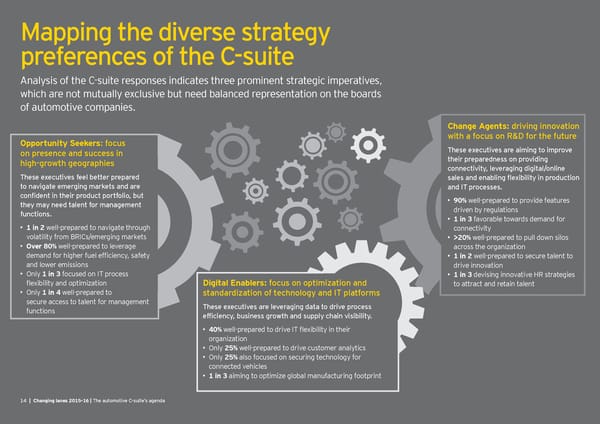Mapping the diverse strategy preferences of the C-suite Analysis of the C-suite responses indicates three prominent strategic imperatives, which are not mutually exclusive but need balanced representation on the boards of automotive companies. Change Agents: driving innovation Opportunity Seekers: focus with a focus on R&D for the future on presence and success in These executives are aiming to improve high-growth geographies their preparedness on providing connectivity, leveraging digital/online These executives feel better prepared sales and enabling fl exibility in production to navigate emerging markets and are and IT processes. confi dent in their product portfolio, but • 90% well-prepared to provide features they may need talent for management driven by regulations functions. • 1 in 3 favorable towards demand for • 1 in 2 well-prepared to navigate through connectivity volatility from BRICs/emerging markets • >20% well-prepared to pull down silos • Over 80% well-prepared to leverage across the organization demand for higher fuel efficiency, safety • 1 in 2 well-prepared to secure talent to and lower emissions drive innovation • Only 1 in 3 focused on IT process • 1 in 3 devising innovative HR strategies flexibility and optimization Digital Enablers: focus on optimization and to attract and retain talent • Only 1 in 4 well-prepared to standardization of technology and IT platforms secure access to talent for management These executives are leveraging data to drive process functions effi ciency, business growth and supply chain visibility. • 40% well-prepared to drive IT flexibility in their organization • Only 25% well-prepared to drive customer analytics • Only 25% also focused on securing technology for connected vehicles • 1 in 3 aiming to optimize global manufacturing footprint 1414 | Changing lane| Changing lanes 2015-16 | s 2015-16 | TThe authe automotivomotive Ce C-suit-suitee’’s agendas agenda
 Changing Lanes Page 13 Page 15
Changing Lanes Page 13 Page 15